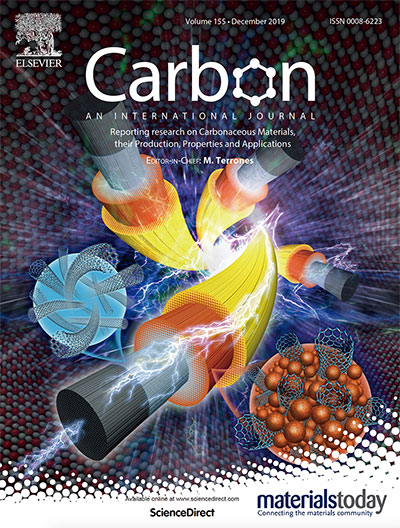-
Project Professor Bunshi Fugetsu and Professor Ichiro Sakata
Joint research paper on carbon-nanotube accepted for publication at the “Carbon” Journal of Elsevier.
Project Professor Bunshi Fugetsu and Professor Ichiro Sakata

A joint research paper by a group including Project Professor Bunshi Fugetsu and Professor Ichiro Sakata “Thicker carbon-nanotube/manganese-oxide hybridized nanostructures as electrodes for the creation of fiber-shaped high-energy-density supercapacitors”
has been accepted for publication at the “Carbon” Journal of Elsevier.
The diagram of the principle idea of this paper made the cover of Volume
155 of the same journal.
Overview
Wearable & washable vital sensors (WWVS) are one of the essential scientific elements for promoting of the well-aging societies. Fiber-shaped supercapacitors (FSC), due to their wearable nature, lightweight and high flexibility, have long been expected to be the most desirable power source for powering of WWVS. Their intrinsic weakness of the limited energy densities, however, has been the bottleneck encountered in their commercialization. A novel Faradaic-FSC with manganese oxide (MnO2) functioning as active (redox) materials and carbon nanotubes (CNT) as electro-conductive paths is established (Carbon, Vol. 144, P169-177, 2019) to overcome the low energy density difficulty of the common FSC. MnO2 stores energies (electrons) via electrochemical intercalations, i.e., i) cations of the electrolyte intercalate into the crystal cavities of MnO2 and ii) at the same time, electrodes deliver electrons in to MnO2 to maintain the charge neutrality. MnO2 is an electrically insulated substance in nature; electrons can penetrate to MnO2 but be restricted to a theoretical depth of 420 nm. It is demonstrated for the first time that thicker yet reactive MnO2 based redox hybrids (thereby the higher energy densities) are obtainable through the creation of macro-sized hybrids via electrochemically inserting of nano-sized MnO2 particles into densely interconnected CNT networks. CNT networks can be visualized as nano-sized capillaries and the nano-sized MnO2 domains as tissue cells. Electrons are rapidly delivered via the highly electric conductive CNT-networks; nano-sized MnO2 domains are thereby being effectively activated. This self-electric-conductive CNT/MnO2 hybrid can be loaded up to a thickness of 150 μm on electrodes while rates of transfer of electrons and electrolytes remain excellent. A scientific illustration (illustrator, Mr. Shinichoro Kinoshita) showing the concept of “tissue-cells/capillaries” cooperation is appearing as the cover image of Carbon Vol. 145, 2019.
Title:
Thicker carbon-nanotube/manganese-oxide hybridized nanostructures as electrodes for the creation of fiber-shaped high-energy-density supercapacitors
Collaborative Researchers:
Wei Gong, Bunshi Fugetsu, Zhipeng Wang, Takayuki Ueki, Ichiro Sakata, Hironori Ogata, Fei Han, Mingda Li, Lei Su, Xueji Zhang, Mauricio Terrones, Morinobu Endo
Journal:
Carbon, Volume 154, December 2019, Pages 169-177
https://doi.org/10.1016/j.carbon.2019.08.004